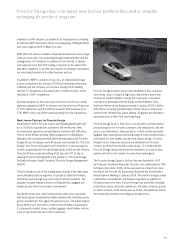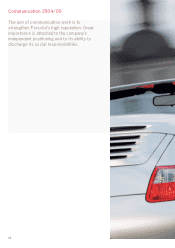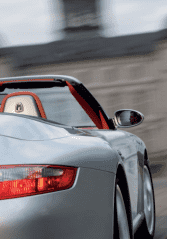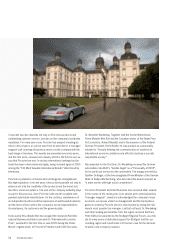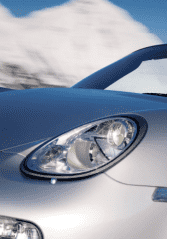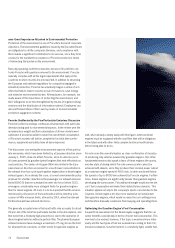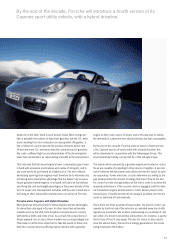Porsche 2004 Annual Report Download - page 67
Download and view the complete annual report
Please find page 67 of the 2004 Porsche annual report below. You can navigate through the pages in the report by either clicking on the pages listed below, or by using the keyword search tool below to find specific information within the annual report.
63
Porsche’s historical foundation is built on the work of Professor
Ferdinand Porsche and its continuation by his son Ferry. To reflect this,
the museum display will focus on the complex history that began
with Ferdinand Porsche’s early designs and continues in today’s de-
velopment work. With the social scene in the past hundred years
as a setting, technical and entrepreneurial initiatives of the past
and those that have made Porsche what it is today, an independent
automobile manufacturer that is now the most profitable anywhere
in the world, will be presented and explained.
Visitors will learn how Porsche’s conception of itself influences its
products and the company’s activities. Close proximity to Zuffenhau-
sen and the production plant there, and in particular the charm of a
museum that invites its guests to be ‘among friends’ will communica-
te a sense of having reached the home of Porsche and of sensing
the unique tradition of this manufacturer at close quarters.
Together with the main Porsche AG production plant and the sales
subsidiary in the immediate vicinity, the Museum will in future acts
as the company’s calling card. At this traditional Porsche production
location, it will demonstrate Porsche’s presence to visitors and
employees alike, and contribute a new accent to what is largely an
industrial and trade area. The new building, by upgrading the site sur-
rounding Porscheplatz, will also make a worthwhile contribution to
the urban development of the Zuffenhausen suburb of Stuttgart.
The ‘Rolling Museum’ Concept is to Continue
The historical public relations work undertaken by Porsche also
maintains its corporate tradition outside the Zuffenhausen museum.
Selected historic vehicles are frequently dispatched on tour as a
‘rolling museum’, and can be seen year after year at more than
20 oldtimer meetings.
The ‘rolling museum’ policy is to be continued when the new museum
is open. Visitors may well see historic Porsches leaving the premises
to take part in major events elsewhere, for example the Goodwood
Festival of Speed in England, the Targa Tasmania in Tasmania or the
Mille Miglia in Italy. They or other museum guests may equally have a
close-up view of these vehicles returning home after having taken
part in historic race events.
These opportunities will be open to museum guests by virtue of
a ‘showroom workshop’, in which the company’s own exhibits and
historic vehicles owned by customers are serviced or restored.
Customers who entrust their valuable historic vehicles to the work-
shop will be able to see its qualified staff working on their cars. They
will be witnesses to the way that one of the Museum’s most important
tasks is carried out: active conservation of our automobile heritage.
Driving the Porsche 804 Formula One
racing car, Dan Gurney won the 1962
French Grand Prix in Rouen.
Spectators gather round to admire
a 356 Coupe competing in the celebrated
Mille Miglia road race, now an event
for historic cars.
The Porsche 718 RS 60 is one of the many
significant classic automobiles in Porsche’s
history.


